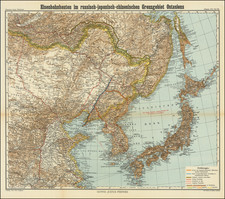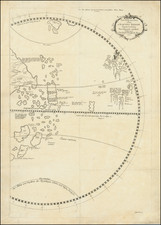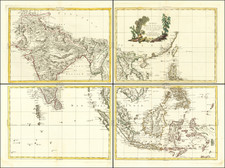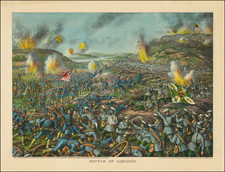Exceedingly rare map of Japan, engraved by Cipriano Bagay in Manila, one of the few maps published in the Philippines in the 18th Century.
This otherwise unobtainable map of Japan was engraved by the native Filipino engraver Cipriano Bagay, and with its delighfully crude style, is a magnificent example of colonial cartographic printing. The cartography and toponomy on Bagay's map is archaic, yet intriguing. It is derived from Jan Jansson's Nova et Accurata Japoniae Terrae Esonis ac Insularum adjacentium (Amsterdam, 1658), which is itself based on Maarten Gerritz Vries's manuscript map, which resulted from his 1643 trip around Japan. The Dutch origin of the map is revealed by Bagay's inclusion of the name 'De Noorthoeck van Japan', to indicate the northernmost point of Honshu.
While the islands of Honshu, Kyushu and Shikoku are easily identifiable (Hokkaido is totally absent), their form is somewhat crude and the placement of cities within the country is far from precise. 'Meaco', the archaic name for Kyoto appears prominently, but far to the northwest of its true position, while 'Iedo' (later Tokyo), the headquarters of the ruling Tokugawa Shogunate, appears inland of its true position. The east coast of Korea is shown in vague outline, as Bagay is not drawn into the question as to the peninsularity of Korea.
Other archaic names include Shikoku, which appears as 'Tokoesi', and confusingly Kyushu is named 'Cikoko', indicated that the 17th Century Europeans misunderstood the real name of Kyushu, confusing it with the name for Shikoku. This stems from the fact that the archaic Japanese name for Kyushu was "Tsukushi", which sounds something like "Tokoesi".
The map is from Juan de la Concepción's Historia General de Philipinas (Manila, 1788-1792), an incredibly rare 14 volume work that was a monument of Filipino scholarship and one of the grandest works of colonial publishing produced in the 18th Century. The map appeared in Volume 2, opposite page 232, and was published in 1788. The Historia General was engraved by Cipriano Bagay and Felipe de Sevilla, with the present map of Japan being from Bagay's burin, as "C. Bagay Scul[pcit]" appears in the lower right of the map.
Although his work was consequential, not much is known of Cipriano Bagay, although he was the son of Nicolas de la Cruz Bagay (1701-1771), the great native Filipino pioneer of printed cartography. Nicolas was born in Tambobong, now the municipality of Malabon. Trained and educated by the Spaniards, he was a renowned native expert in engraving and printing, whose first work of significance was the engraving for Pedro Murillo Velarde's Mapa de Filipinas (Manila, 1734), the first detailed map of the Philippines, and arguably the most impressive work of cartography ever printed in the Spanish colonies. His name also appeared on a reduced 1744 edition of the Murillo map, printed with a copper plate. Nicolas Bagay continued in the printing business for a number of years, his name appearing as the printer of many of the most important works published in the Philippines in the mid-18th Century. He was succeeded by his son Cipriano, one of only a few map makers to publish maps in the Philippines prior to 1800. It is estimated that no more than 20 maps were published in the Philippines prior to 1800.
The map is extremely rare. We know of no separate example of the map at auction or in a dealer catalog and only 2 examples of the Concepcion's book in the past 100 years at auction, none since the 1970s. This is the second example we have offered for sale in over 20 years.












![[American Lady] [Amerika fujin] | [Chinese Man from Nanjing] [To Daishin Nankin-jin]](https://storage.googleapis.com/raremaps/img/small/55554.jpg)

![(Commodore Perry) [Clans Assigned to Defence Duty on Land and Sea for Maintaining Peace] [Kairiku okatame taihei kagami]](https://storage.googleapis.com/raremaps/img/small/55561.jpg)